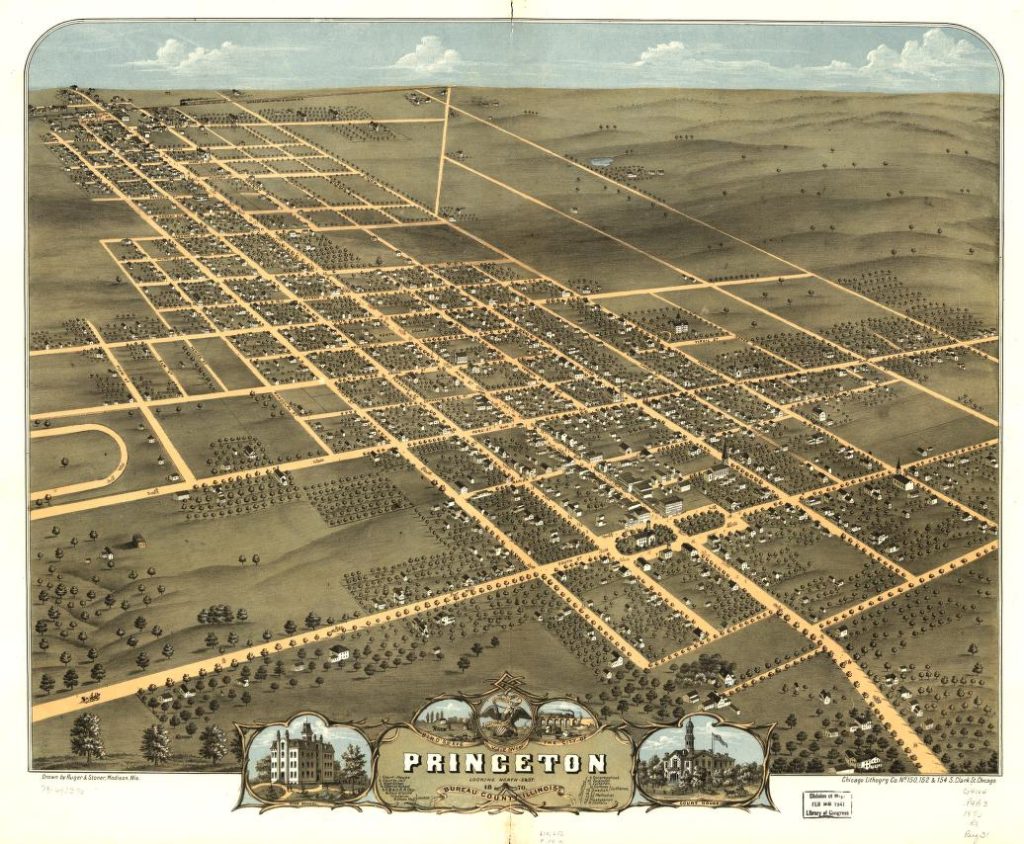After a few short years of hiatus, #SmallTownSaturday is back!
This month, we are looking at the town of Princeton in Bureau County, Illinois. The county was established in 1837, with Princeton as the county seat.

Princeton was formed in the early 1830s as a transplant colony for the Hampshire Colony Congregational Church of Northampton, Massachusetts. It became a stop of the Chicago, Burlington, and Quincy Railroad in the 1850s and began expanding quickly. Abraham Lincoln himself stopped in Princeton in 1854. Lincoln gave a well-attended speech in Bryant Woods on the Fourth of July 1854.
Bryant Woods was named for three of the town’s prominent early members, Cyrus (1798-1865), Arthur (1803-1883), and John Howard Bryant (1807-1902). The Bryants were born in Massachusetts. Arthur traveled West and moved to Jacksonville, Illinois, in 1830. He wrote to his brothers that year describing the early Illinois landscape, listing the price of common goods, and recommending that his brothers move west. IHLC has a transcript of this letter available for researchers (MS 495).
Cyrus and John arrived in Princeton in 1832, and all three brothers built cabins and farms close to each other. John Howard Bryant was an early editor of one of Bureau County’s first newspapers and an active political figure. He was also an author and earned himself the nickname “the Farmer Poet.”

A close friend of John Howard Bryant was abolitionist Owen Lovejoy (1811-1864), who moved to Princeton in 1838 following the murder of his brother, Elijah Lovejoy, in Alton, Illinois. Owen Lovejoy preached anti-slavery as the pastor of the Congregational Church in Princeton from 1838 to 1856. Both Bryant and Lovejoy’s homes served as shelters on the Underground Railroad. Lovejoy’s house became a National Historic Landmark in 1997 and is now a museum.
IHLC has many materials on Owen Lovejoy, including a copy of this State of the Union speech (also available online) that he delivered to the House of Representatives in 1861. Check out the linked resources under “IHLC Resources” for more on Owen and Elijah Lovejoy.

Another prominent family in early Princeton was the Langworthys. Cyrus Langworthy (1791-1874) moved to the newly forming prairie town of Princeton from Vermont in 1834. Langworthy was Bureau County’s first sheriff. Langworthy’s son Lucius volunteered for the Union Army in 1861 and wrote several letters home about his experiences. The Taylor-Langworthy papers at IHLC document the lives of the Langworthy’s and Taylors. Cyrus Langworthy’s daughter Sarah married James I. Taylor, a prominent lawyer who moved to Princeton in 1847.
For those interested in Princeton’s more recent history, check out this guide to Princeton from 1939. George V. Martin created the guide for the Federal Writers’ Project with information on the town’s history and information for visitors. In it, he wrote of Princeton, “Here is a town of merchants and retired farmers, where everybody knows everybody else, and the title Mister is seldom heard. Even the Mayor is called by his first name.” Martin spoke very highly of the small town’s business districts, the North and South End, and the farmland surrounding it, referring to them as “God’s Acres.”
Want to learn more about the history of this small town? Come visit us at the Illinois History and Lincoln Collections! From books like the photographic history Princeton, Illinois, to manuscript collections like the Hampshire Colony Church Record Book and Taylor-Langworthy Papers, we have a wealth of resources available to anyone interested in historic Princeton, Illinois.
ILHC Resources
Archival materials:
- MS 918: Hampshire Colony Church Record book, 1847-1863
- MS 087: Owen Lovejoy Letter, 1860
- MS 1010: Lovejoy Society Papers, 1996-2014
- MS 311: Taylor-Langworthy Families Papers, 1817-1895, 1912
- MS 327: Todd, David, and Charlotte Farnsworth Letters, 1846-1874
- MS 333: Jonathan Baldwin Turner Papers, 1823-1924 (includes correspondence with Owen Lovejoy)
- MS 495: Letter from Arthur Bryant to John Howard Bryant, 1830
Print materials:
- Belden, David A. Princeton. Arcadia, 2010.
- Bradsby, H. C. History of Bureau County, Illinois. World Pub. Co., 1885.
- Bryant, John Howard. Life and Poems: of John Howard Bryant. Streeter & Co., 1889.
- Leonard, Doris Parr. A Pioneer Tour of Bureau County, Illinois. Bureau County Republican, 1954.
- Leonard, Doris Parr. Big Bureau and Bright Prairies; a History of Bureau County, Illinois. Bureau County Board of Supervisors, 1968.
- Martin, George V. Princeton Guide : Federal Writers’ Project (Illinois) Works Progress Administration. Republican Printing Company], 1939.
- Matson, N. (Nehemiah). Reminiscences of Bureau County : with Original Illustrations. Tiskilwa Chief Print. Office, 1937.
- Princeton, Illinois. Tribune Print. Co., 1969.
- Skilling, G. W., and E. H. Masters. Beautiful Bureau : a Collection of Photographic Reproductions of the Picturesque, Historical, or Otherwise Interesting Scenes of Bureau County, Illinois. [S.n.], 1894.
